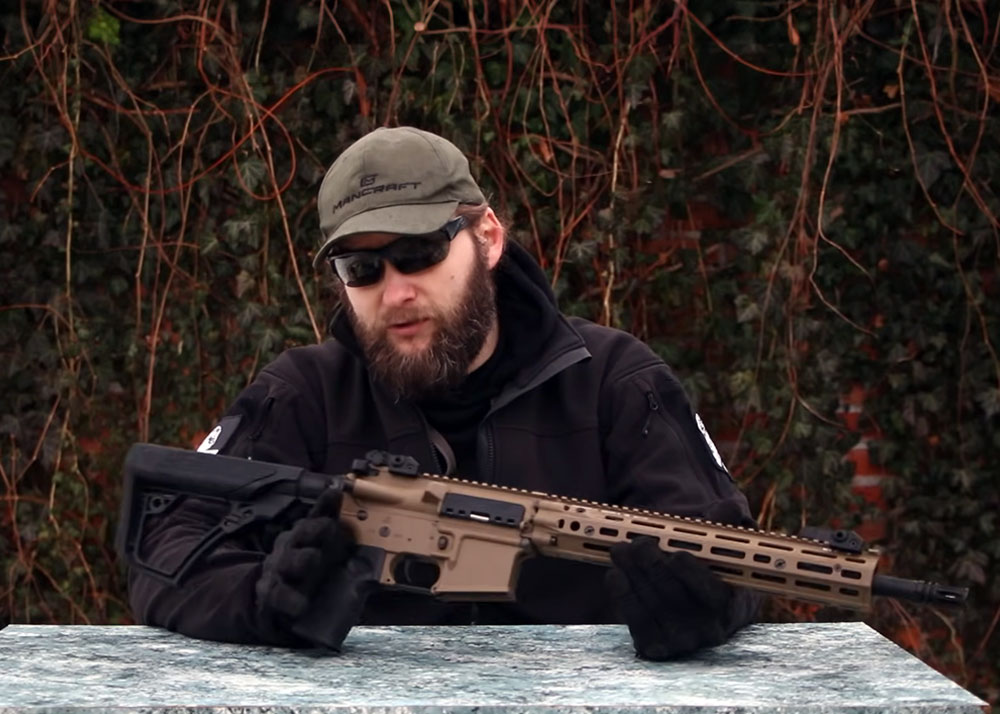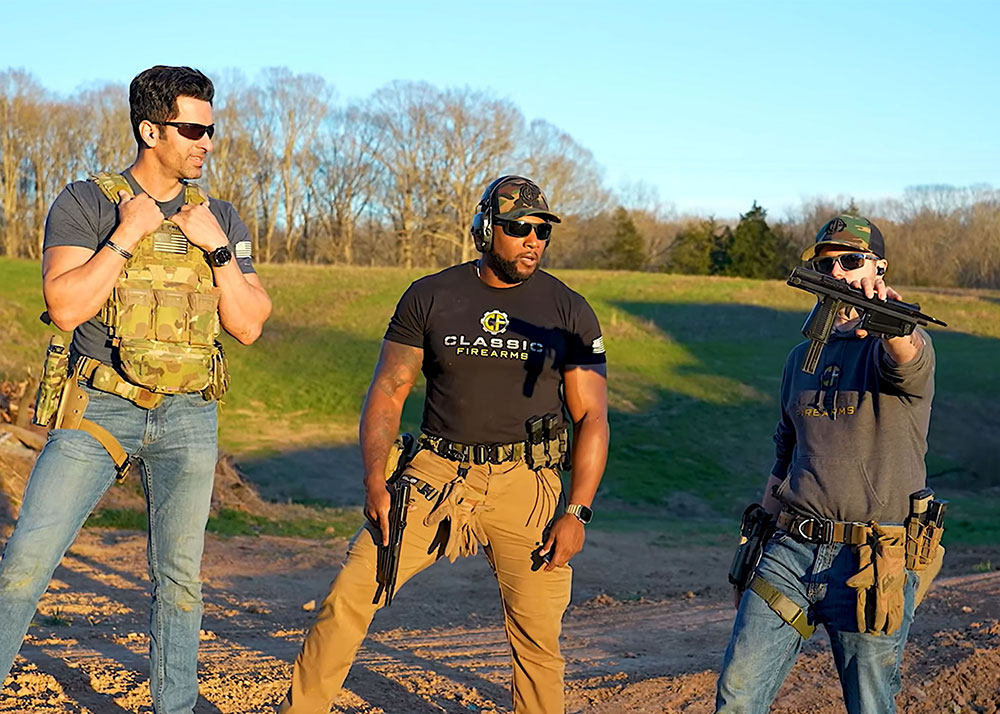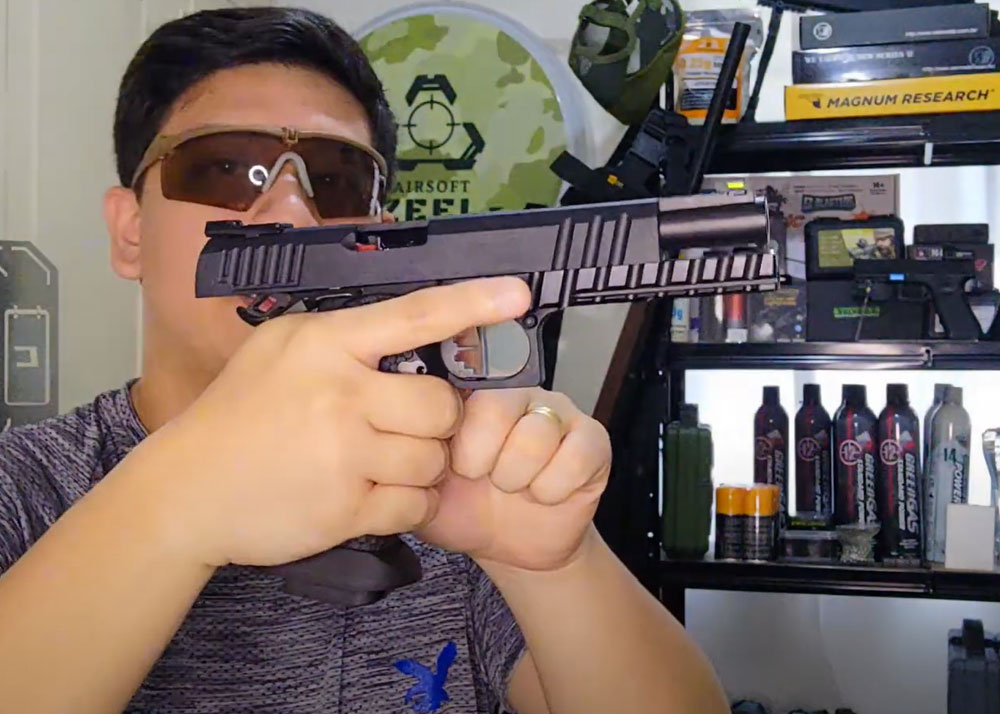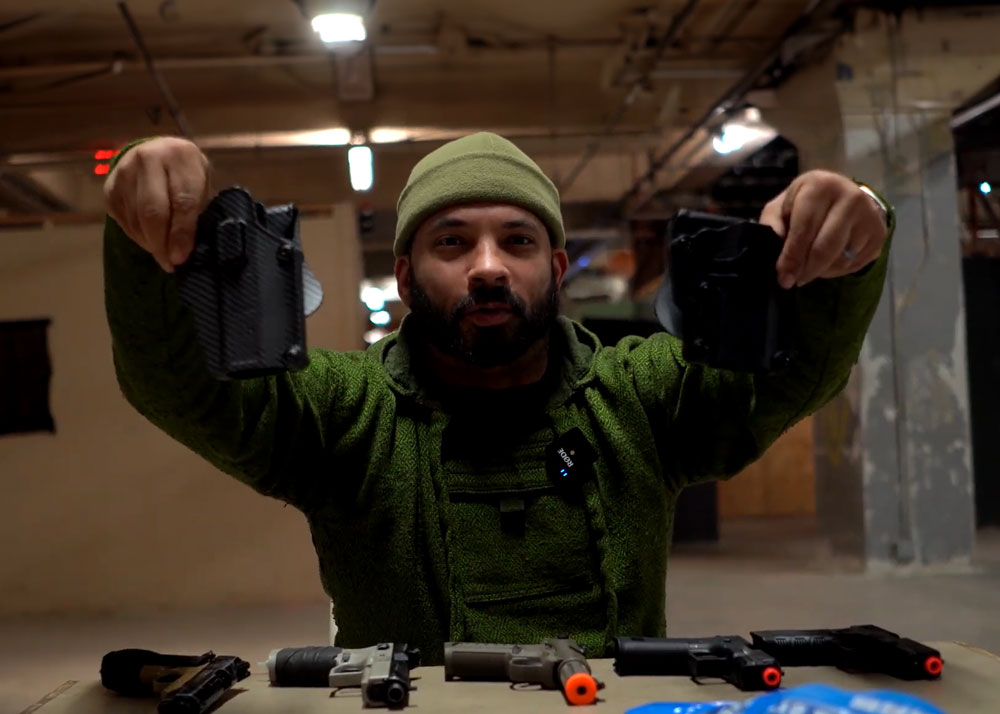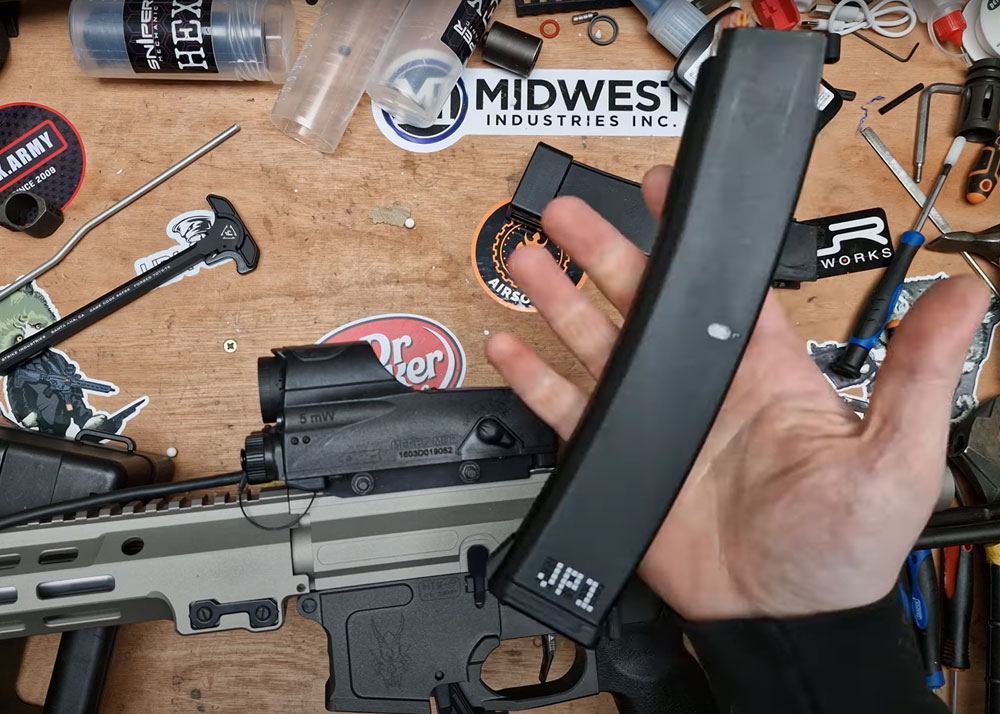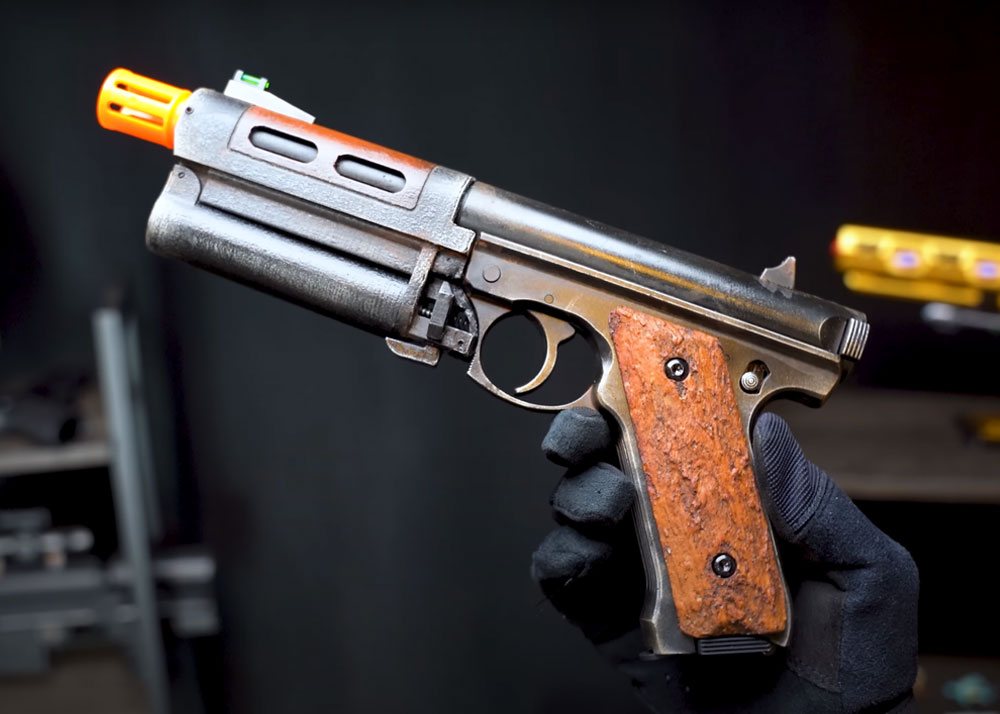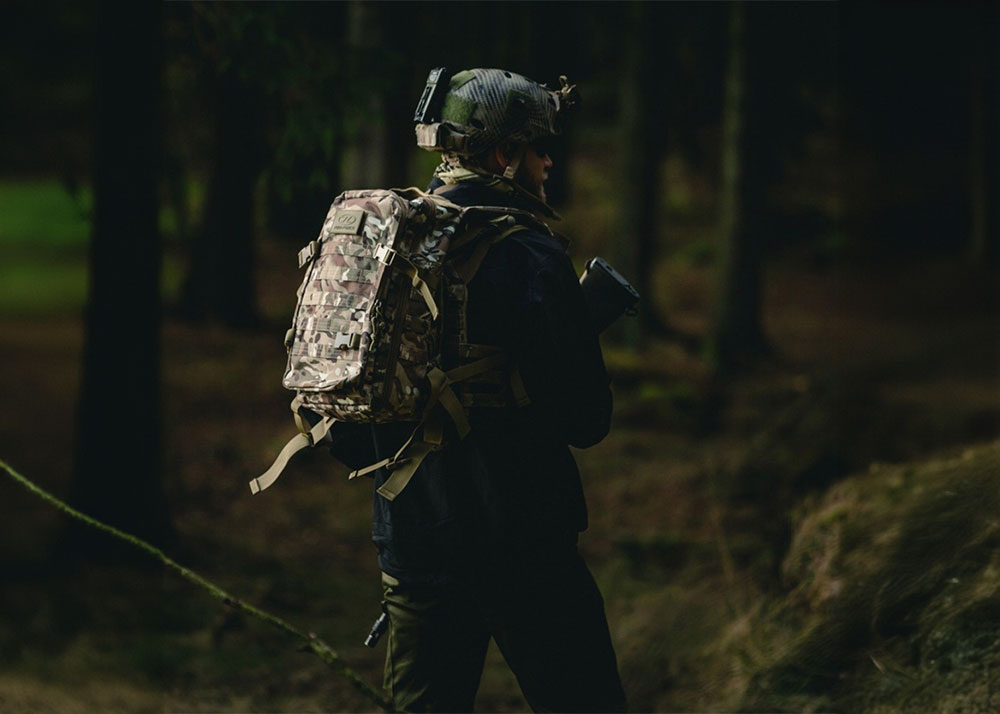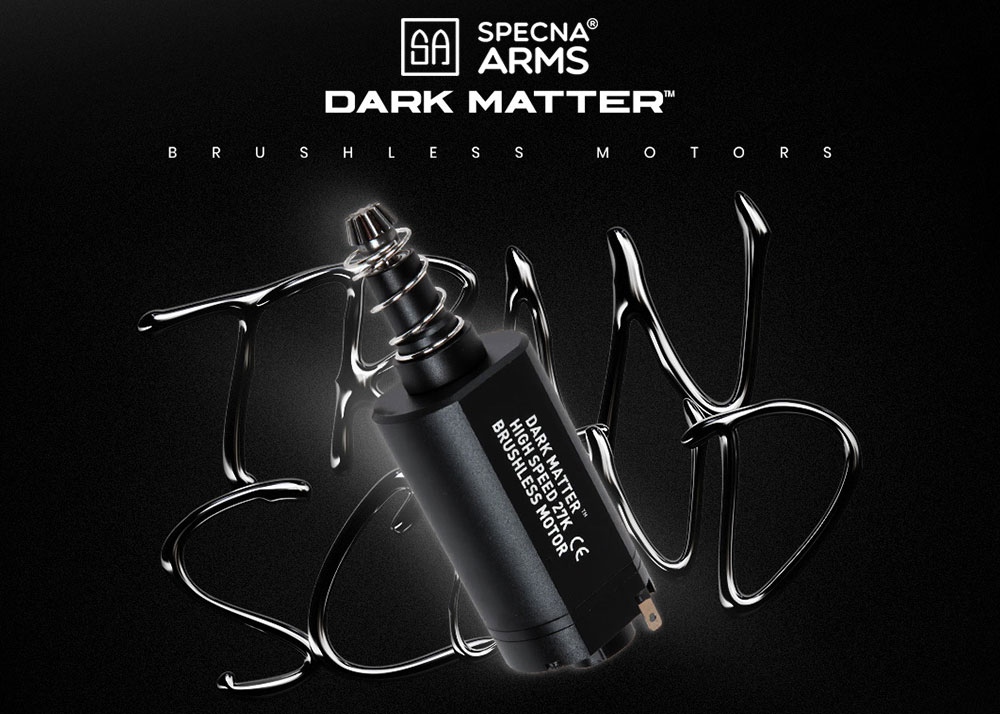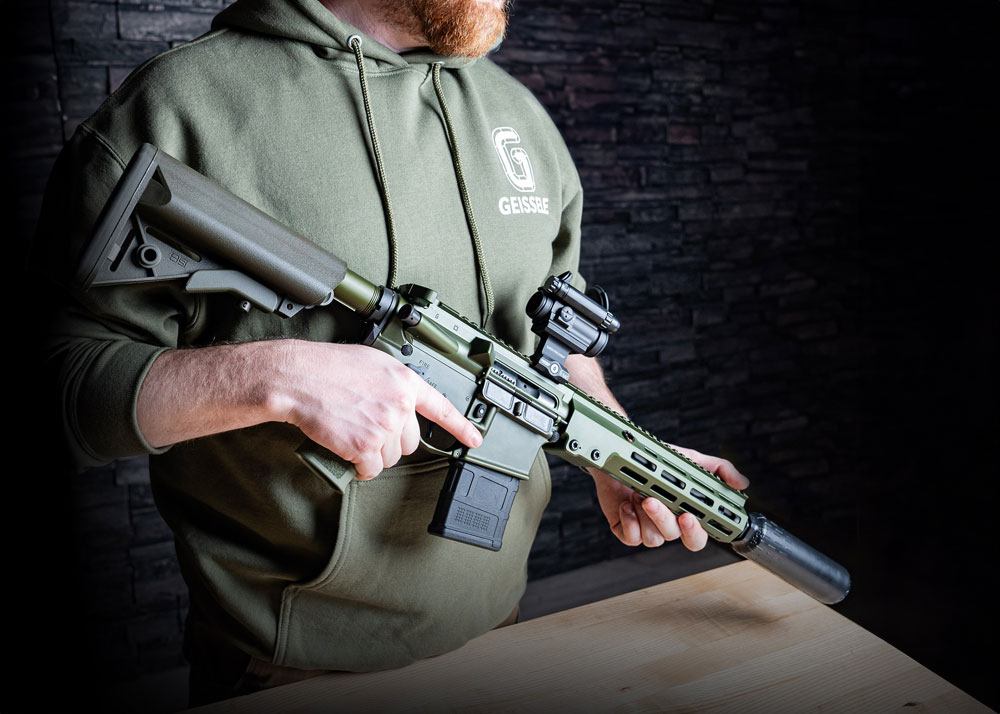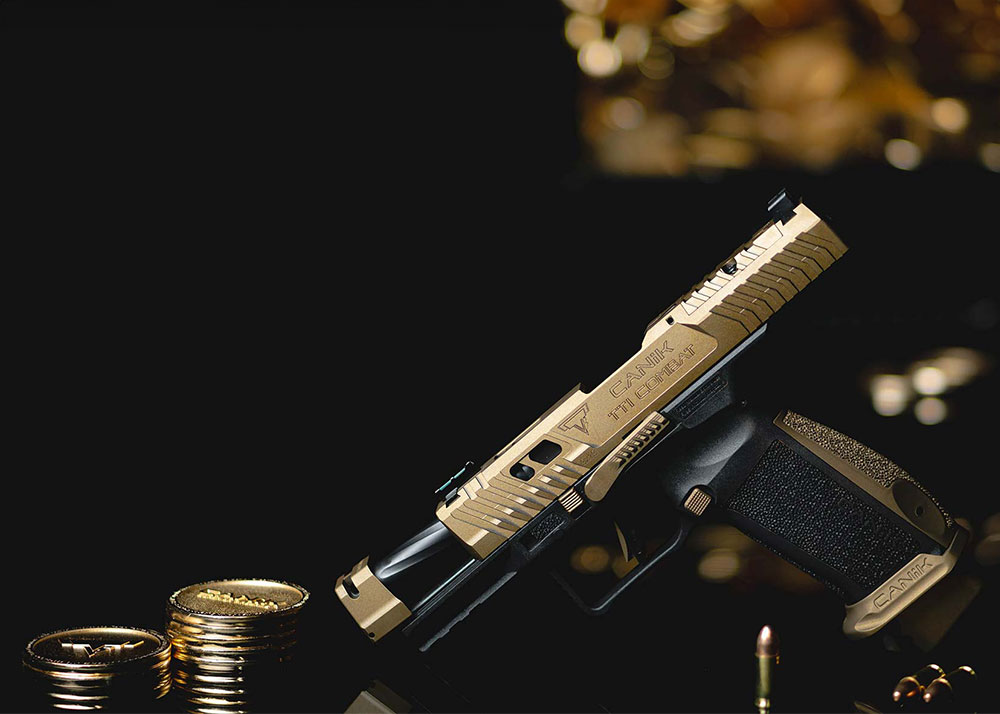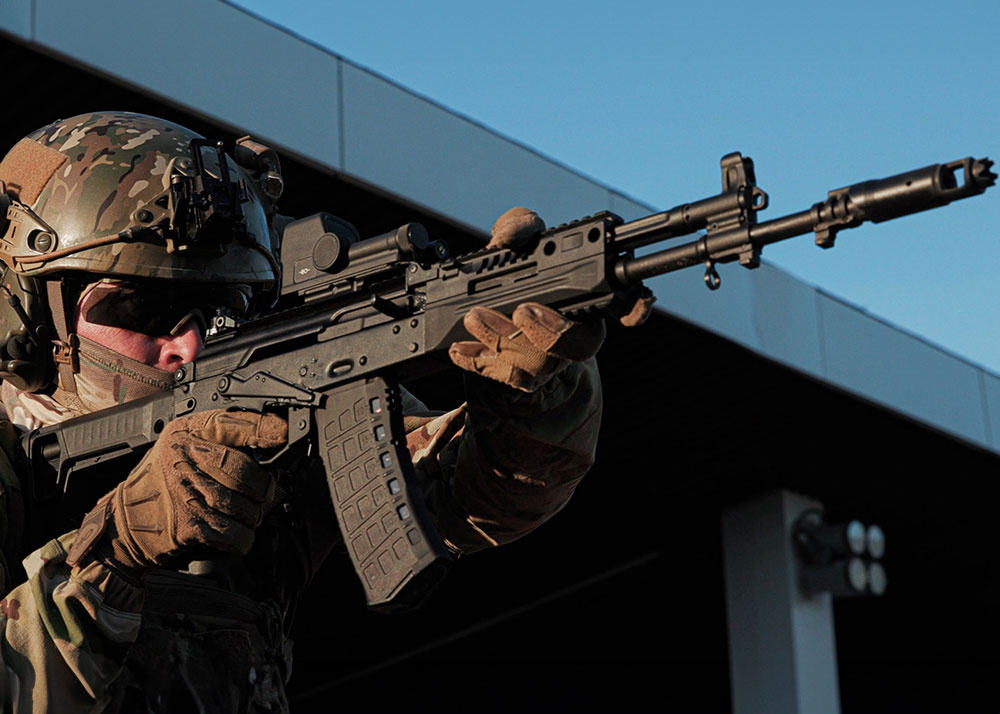King Arms SIG 556 HOLO Blowback AEG
Migh2r
23 Sep 2010
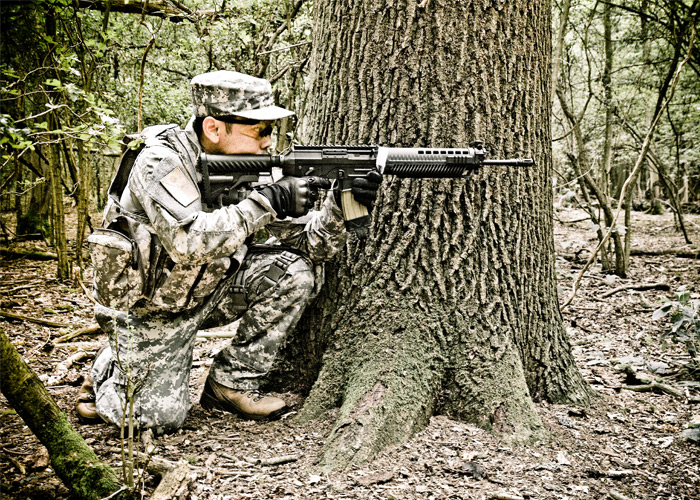
The 556 is based on the popular 550-series design of SIG’s sister company, Swiss Arms. The 550 series uses Swiss Arms’ two-position adjustable gas-piston operating-rod system, which is known for its unflappable reliability. The key? Unlike the AR-15’s direct-gas-impingement system, the 550 series’ piston-driven system vents gases and unburned powder out to the front of the weapon rather than back into the action. This results in a cleaner, cooler-running system that is more reliable and easier to clean. Piston-driven systems are also less fickle with short barrels and suppressors, which means the 556 can easily be made into a short-barreled rifle (with the proper paperwork) or adapted to suppressor use.
A DESIGN REFINED
One notable deviation from the 550 series is the 556’s trigger housing, which accepts standard AR-15 magazines. The new design is machined from an aircraft-grade aluminum-alloy forging, which shaves a pound of weight from the original design. The trigger guard swings down for gloved use.
But SIG did more than update the 550 series’ trigger housing when it designed the new 556. First, as much as I like the 550’s diopter sights, SIG ditched them for a lighter, more compact flip-up design. The front sits atop the gas block, and the rear is recessed into the integral Picatinny rail.
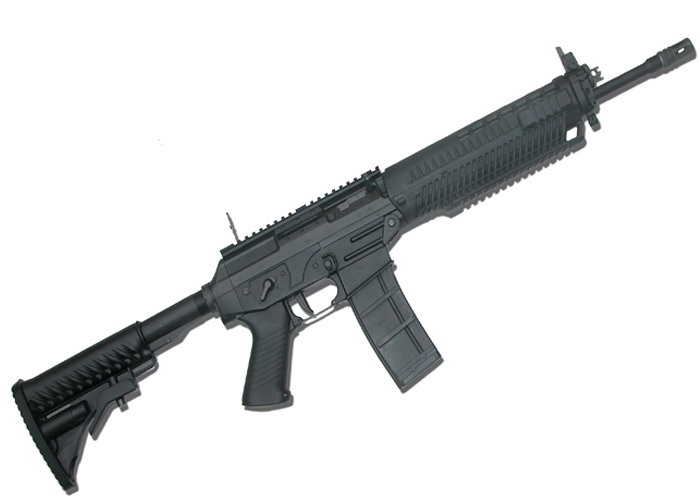
The top of the receiver is not the only part to sport a rail; the hand guard is a tri-rail design, with full-length rail at the bottom and short rail on both sides.
Other features include an ambidextrous safety selector, a two-stage trigger, an AR-style protected magazine release on the right side of the receiver and a bolt-release lever on the left side that is big enough to provide a substantial amount of leverage. Closing the bolt - which locks back on an empty magazine - was a breeze with the oversize lever.
(excerpt taken from www.gunsandammomag.com)
AIRSOFT REPLICA
The King Arms airsoft version actually resembles the real steel SIG 556 ER rather than the SIG 556 HOLO which comes with a red dot style holographic sighting system. Both models are identical except for the addition of the holo sight on the latter model. Nevertheless, the airsoft model has faithfully replicated the external dimensions and looks of the real steel from the 0.5 x 28 TPI thread pattern flash suppressor down to the retractable stock with rubber butt plate.
The forearm housing the 8.4V mini battery is top vented nylon fibre featuring the SIG TriRail design with three picatinny rails for mounting various accessories such as torchlight and laser pointing system. The metal flip-up front combat sight is adjustable for windage and elevation. The lower part of the nylon fibre front end can be removed by pushing the locking pin out from the right side of the receiver and then sliding it backwards till it disengages from the front and upper handguard. The space inside can accommodate a 9.6V mini type battery with a mini tamiya plug should you decide to use one.

The receiver body is full metal with a screw-on top picatinny rail unlike most AR AEG models whose rails are integrated with the body. The left side of the upper receiver has full markings that read “SIG 556 5.56 NATO, SIGARMS INC, EXETER, NH, USA”. The lower receiver bears the markings “JS 106382”. On the right hand side of the receiver, there is a set of numbers marked on the ejection port cover which is likely King Arms serial numbering. Like all the metal parts of the gun, it is finished in matt black that matches the matt color of the nylon fibre furniture of the rifle.
The picatinny rail houses a tiny, flimsy flip-up rear sight that is recessed into it if not in use. It looks a bit out of proportion to the overall size of the rifle. This is not a design fault of King Arms but is based on the real steel model. I reckon that this is beneficial to the airsoft version because it will keep the cost down compared to the diopter rear sight. I am pretty sure as well, that most owners of this AEG would mount their own type of sighting system for a more “macho look”. Not to be underestimated, the rear sight works just fine in tandem with the front sight once properly adjusted.
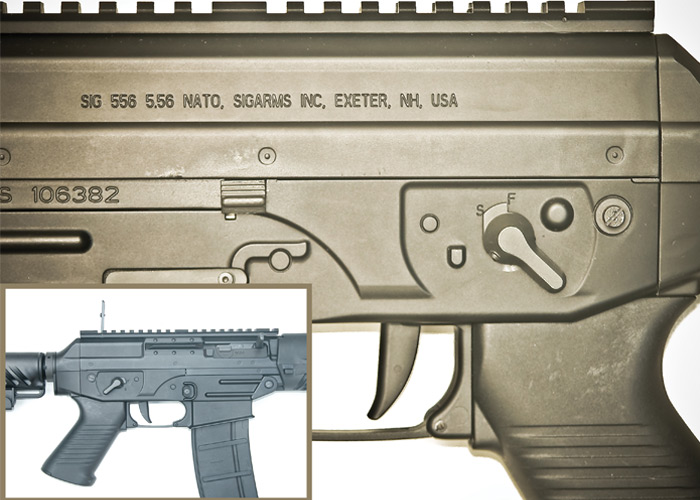
There is no bolt catch to steady the blowback mechanism should you try to adjust the hop-up. This means that you have to hold the ejector port open to access the hop-up as shown in the photo. This method is almost similar to most AEG’s in the market nowadays. The mechanical blowback that hooks to the inside of the gearbox can be disabled with a slight modification without opening up the gearbox. The magazine release is situated on the right side of the receiver and is similar to AR AEG’s. A dummy bolt release lever is located on the left side of the receiver. This model will take magazines based on the 5.56 NATO chamber.
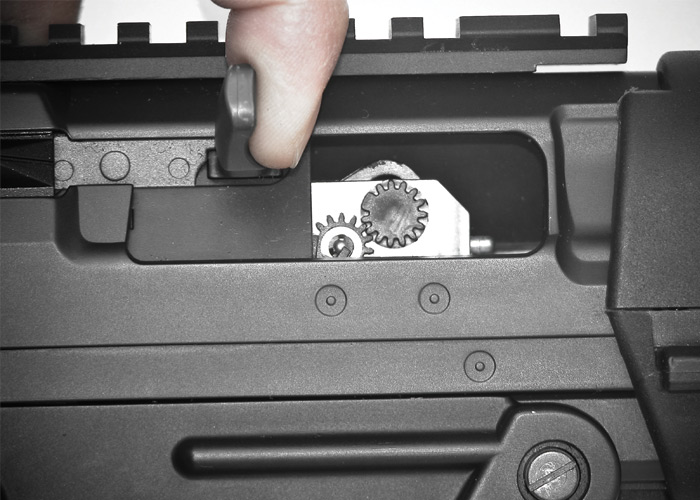
One prominent feature of this rifle is the wide space in the trigger housing allowing the use of thick gloves by operators. This however, makes it difficult for smaller handed persons to swiftly release the magazine without altering your grip, as in my case. This is in comparison with AR AEG’s where the magazine release is within index finger length while maintaining secure hold on the pistol grip of the rifle. Off course, it only needs constant usage and practice to get used to it. The trigger guard can also be flipped open if there is a need to.
Located within a thumb’s reach is the ambidextrous fire selector lever. The design however, is a bit dodgy to my liking. The receiver face is only marked with S and F on both sides. There are no dots or lines to clearly indicate the exact location where the lever should point. The lever itself is oddly shaped with no precise pointer. It is confusing at a glance to know what is the fire mode selected without firing the gun. The precise indications are only whn you do an extreme push upwards to put in safe Safe and an extreme push downwards to select Full automatic. Semi-automatic is at the middle section but it would depend on which part of the lever you are basing it from. It could either be the main lever body or the protruding bit. The audible click that signifies a selected fire mode is hardly heard or felt when adjusting the lever. It just takes time to get accustomed to this. Maybe, King Arms would address this issue. Normally, single shot rifles are marked with S for Safe and F for Fire on their fire selector. SIG 556’s got three modes: Safe, Semi and Full auto.
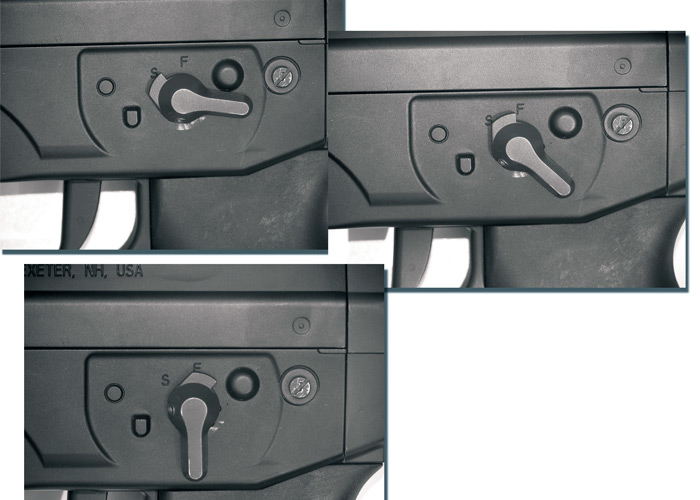
Going to the rear of the rifle is the 6-position retractable nylon fibre stock with a removable rubber butt plate. It employs a stock tube similar to AR AEG’s thus it is possible to replace the stock with an upmarket one according to your liking. A storage tube is integrated in the stock for storing small items like batteries or multi-tools. Our review item has a noticeable play between the metal stock tube and the nylon fibre stock. There are two sling points to choose from just like at the front end. The stock design has adopted the “shark gills” pattern of the front end albeit the slant is to the opposite direction (like a forward slash).
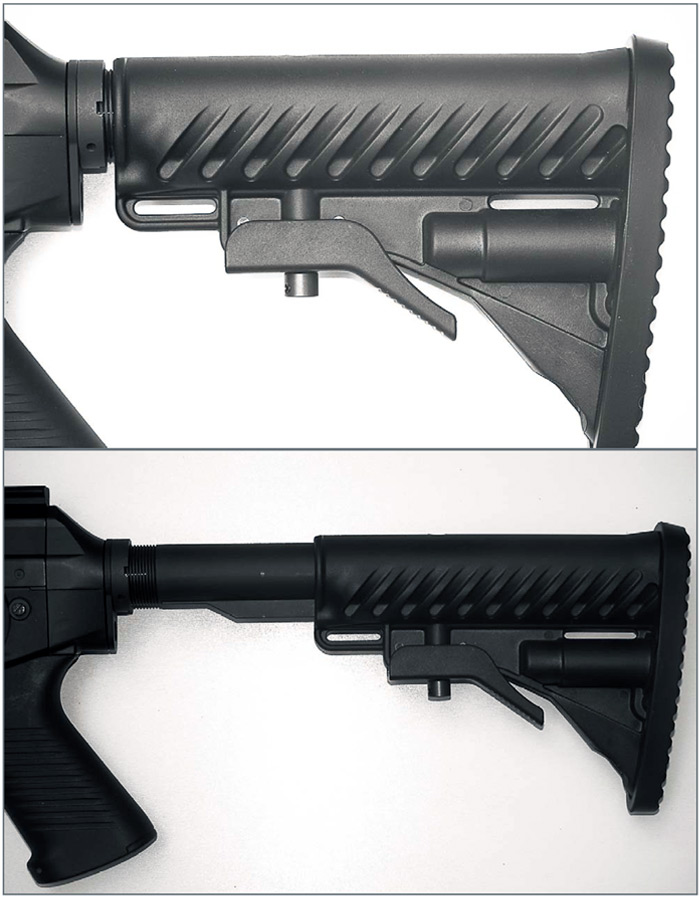
The most prominent feature of this rifle is what I call “shark gills” pattern of the lower handguard. I would assume that this is to aid in dispersing the heat generated from the inside of the front end in the real steel version. In my opinion, the entire lower handguard is a heatsink and the “shark gills” are the gills for the gun to “breathe” keeping it cool inside and also for handling. In the airsoft version, this is more on aesthetic and character rather than function.
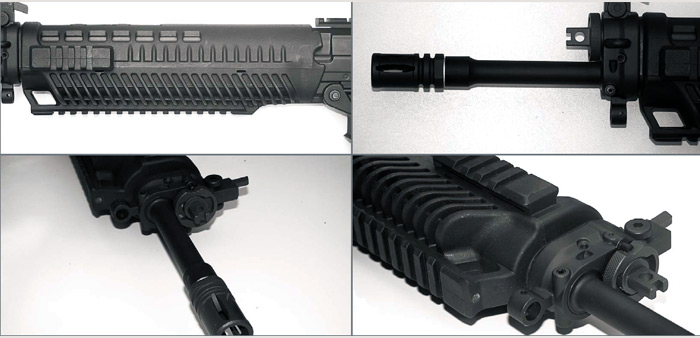
INTERNALS
The gearbox type that King Arms adopted for the SIG 556 HOLO is a Version 3 gearbox with 7mm bearings instead of oily bushings. The left external part of the gearbox sports the visible presence of King Arms’ red coloured plastic selector plate which sits beneath the metal fire selector gear. This side controls the electrical part of the Fire modes. The metal fire selector gear has a clear marking for it to align with the small transfer gear to the right fire selector gear of the gearbox. It is imperative to make the proper alignment of the two gears on both sides otherwise your ambidextrous fire selector switch will not correspond to its function. The right side of the gearbox has the metal fire selector gear which controls as well the mechanical Safe and Fire modes of the gun.
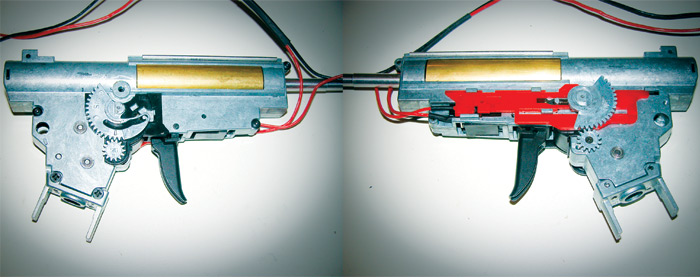
Inside the gearbox, the 7mm bearings can clearly be seen to be sturdily mounted on the casing and properly lubricated for optimum performance. The gears are adequately lubricated and appear to be of good quality metal with an added bonus of a sector clip already installed on the sector gear. An avid airsoft player would normally know the added benefit of a sector clip upgrade to an AEG’s gears. Kudos to King Arms for providing this as a standard part while others make this as an option. The spring on the anti-reversal latch is tensioned just right without letting the beveled gear spring out from its place. This is a common hiccup on version 2 gearboxes of M4 AEGs and variants when putting back the gearbox. The cylinder is metal, brass to be precise with a plastic cylinder head. It comes with a black plastic piston and spring guide and of course, the spring. The red tappet plate is a normal V2/V3 type unlike the selector plate which is gun specific. Attached to it is a rather long aluminum air nozzle. Using a V3 gearbox on a longer receiver resulted in a longer gap between the tip of the tappet plate at the rear and the back of the hop-up unit at the front. Thus, it equated to a gun specific longer air nozzle which just works well as its standard sibling.
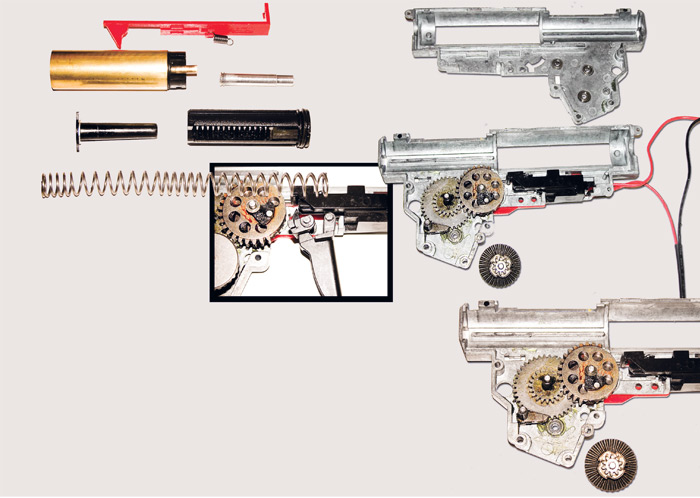
The motor used is a medium type which is void of any markings on its shiny chrome finish. Rather than using a full motor cage, King Arms opted for a metal motor mounting plate with two fins slotting into the ABS hand grip. This ensures a rigid and wobble-free mounting of the motor inside the hand grip to the gearbox. This is in comparison with most M4/M16 and its variants that simply mount the motor direct to the gearbox through the grip.
Stripping the gearbox down was a walk in the park. No ejecting springs or small parts when you open it up as long as you hold tight on the spring/cylinder. The challenging part is putting it back. Unlike other versions where you have to keep an eye on the anti-reversal latch/beveled gear from popping-out, this one stays in place. It is the two-part trigger assembly that keeps on dislodging from its location. Of course, you still have the spring to look out for. Once this has been taken care off, everything will fall in its place.
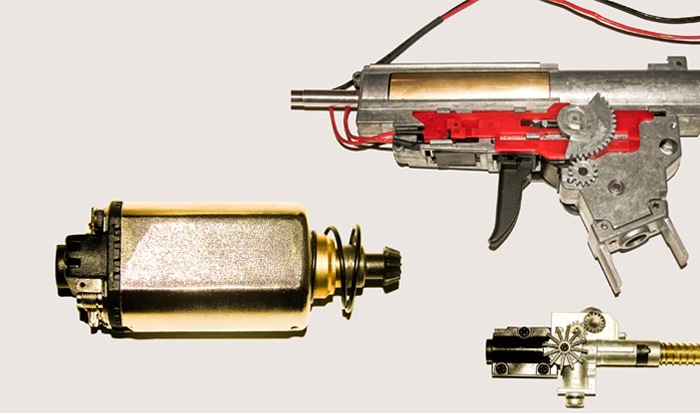
PERFORMANCE
The first thing that you would notice once you pick-up the rifle is its weight relative to its size. It is not that heavy as you would expect for such a large framed rifle. It has shredded weight in the nylon fibre handguard. This makes it less tiring supporting it especially in CQB games where you are always at the ready. The blowback function produces a high pitch metallic clank in each slide of the bolt. It should be noted that since the blowback is dependent on the state of the spring, the bolt could sometimes remain open if the spring is half cocked in full auto mode. This is not a fault. Just fire a few more rounds to rectify or change to semi-auto and fire again to close the bolt.
King Arms was kind enough to throw-in a BB loader in the package considering that this is needed to load BB’s into the included mid-cap magazine. Our chrono reading was 340 – 350 fps out of the box with a freshly charged 8.4V battery. It took some time fiddling with the hop-up to come out with a near perfect BB flight to its effective range of +/- 40m using 0.20g BB. Target practice was however, null and void due to the prevailing strong winds at the test area.
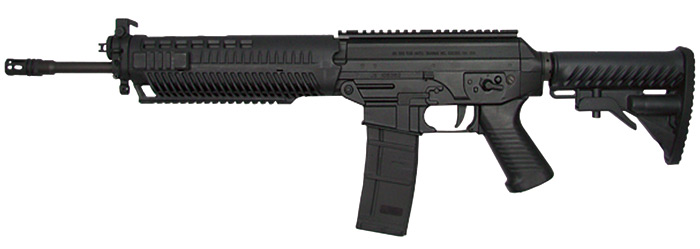
CONCLUSION
King Arms have added a new worthwhile member to their growing stable of world class AEG replicas in the form of Sig Arms 556 Holo. In a world of AEG’s which is flooded with M4/M16 and its variants, it is nice to know that an AEG of this caliber is here to break the mould. You will surely stand out from the crowd once you own one.
There are a host of features that we can admire that makes this rifle stand out from the other AEG’s upon a short glimpse. The prominent “shark gill” pattern on the front lower hand guard and the stock would easily give it away as a Sig 556. The common Sig Arms tri-rail on the front end is also adopted here. The elongated receiver with a wider space for the use thick gloves on the trigger housing and the horizontal pattern on the grip add up to the external character of this rifle. Not to mention the tiny rear sight tucked neatly within the top rail of the receiver when not in use.
Reviewers like us offer the common airsoft players with a glimpse of the innards of airsoft replicas. This enables us to relay to readers the parts and functions of a rifle that you might never be aware exist. This is the case of the sector clip already installed in the sector gear of this AEG. Most, if not all AEG’s normally do not come with a sector clip for this is an option part. You might notice that this Sig 556 will fire nicely without misfeeding. That is because of the sector clip.
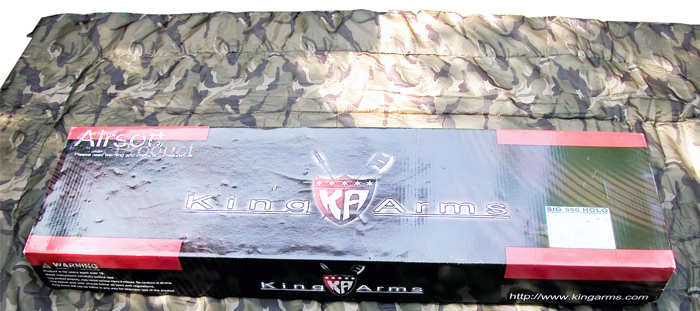
Using this on a skirmish was a joy to behold. I did not use the included low-cap magazine but used instead a hi-cap one from my M4. The range was great with proper hop-up adjustment. The weight distribution was not forward heavy due to its Nylon fibre front end. The rifle is easy to maneuver despite its length and weight.
Overall, this is a nice rifle to be added to one’s collection of faithful airsoft replicas. This AEG version is a break from the common trend which is dominated by the M4/M16 and its variants. The quality of materials and workmanship are the hallmark of King Arms which is hard to fault. The only major lowdown I reckon is the fire selector switch which is not a design fault of King Arms but is rightfully replicated from its original steel version. Other than that, the other minor faults mentioned in the review do not hinder the rifle from performing well in the field. I would give this a 4 out of 5 stars rating. Good work, King Arms!


